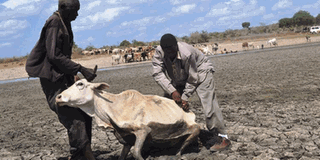UN raises alarm on hunger in Kenya and Eastern Africa

Mzee Karisa Charo (left) from Bandari Village, Kilifi County, is assited to save one of the cows that got stuck in the mud at Giriama ranch water pan due to hunger and emaciation. Mzee Charo said he had lost 56 goats and 55 cows to drought that has ravaged Ganze and Kaloleni sub counties. UN has warmed of more hunger. PHOTO | KAZUNGU SAMUEL | NATION MEDIA GROUP.
What you need to know:
- In Kenya, Somalia and Ethiopia, a total of nearly 12 million people are currently in need of emergency food assistance, FAO calculated.
It included five million Somalis in that number, along with 5.6 million Ethiopians.
Persistence of severe drought is likely to push the number of hungry Kenyans beyond the 1.3 million already considered “food insecure,” a United Nations agency has warned.
“Based on the latest predictions, the impacts of the current drought in the southern part of the country will lessen by mid-2017, but counties in the north — in particular Turkana, Marsabit, Wajir and Mandera — will steadily get worse,” the UN's Food and Agricultural Organisation said.
“Production prospects for the current crops are highly unfavourable and households are expected to enter the next lean season much earlier than usual,” FAO added in an alert covering parts of Kenya and other East African countries.
In Kenya, Somalia and Ethiopia, a total of nearly 12 million people are currently in need of emergency food assistance, FAO calculated.
5 MILLION SOMALIS
It included five million Somalis in that number, along with 5.6 million Ethiopians.
Eastern Tanzania and southeastern Ugandan are also experiencing crop failures due to rainfall amounts far below average this year, the agency noted.
“Production prospects for the current crops are highly unfavourable and households are expected to enter the next lean season much earlier than usual,” FAO said in regard to the affected regions of East Africa.
Terms of trade are becoming increasingly poor for livestock keepers in northern Kenya due to the weakened condition of their sheep, goats and cows, which are bringing lower market prices, the UN agency said.
FAO is helping local officials improve management of livestock markets, in addition to providing feed, water and veterinary support in drought-afflicted pastoral areas of Kenya, the agency reports.




